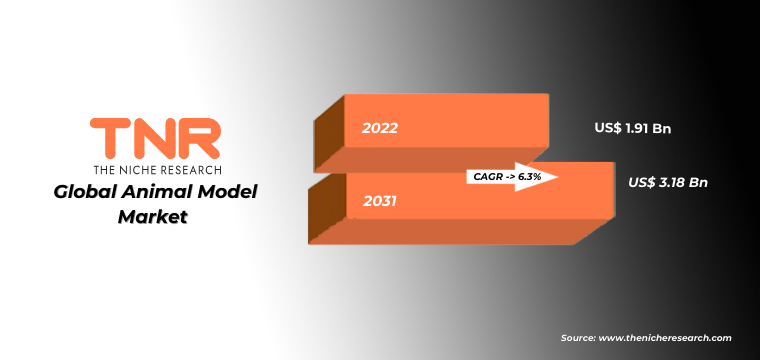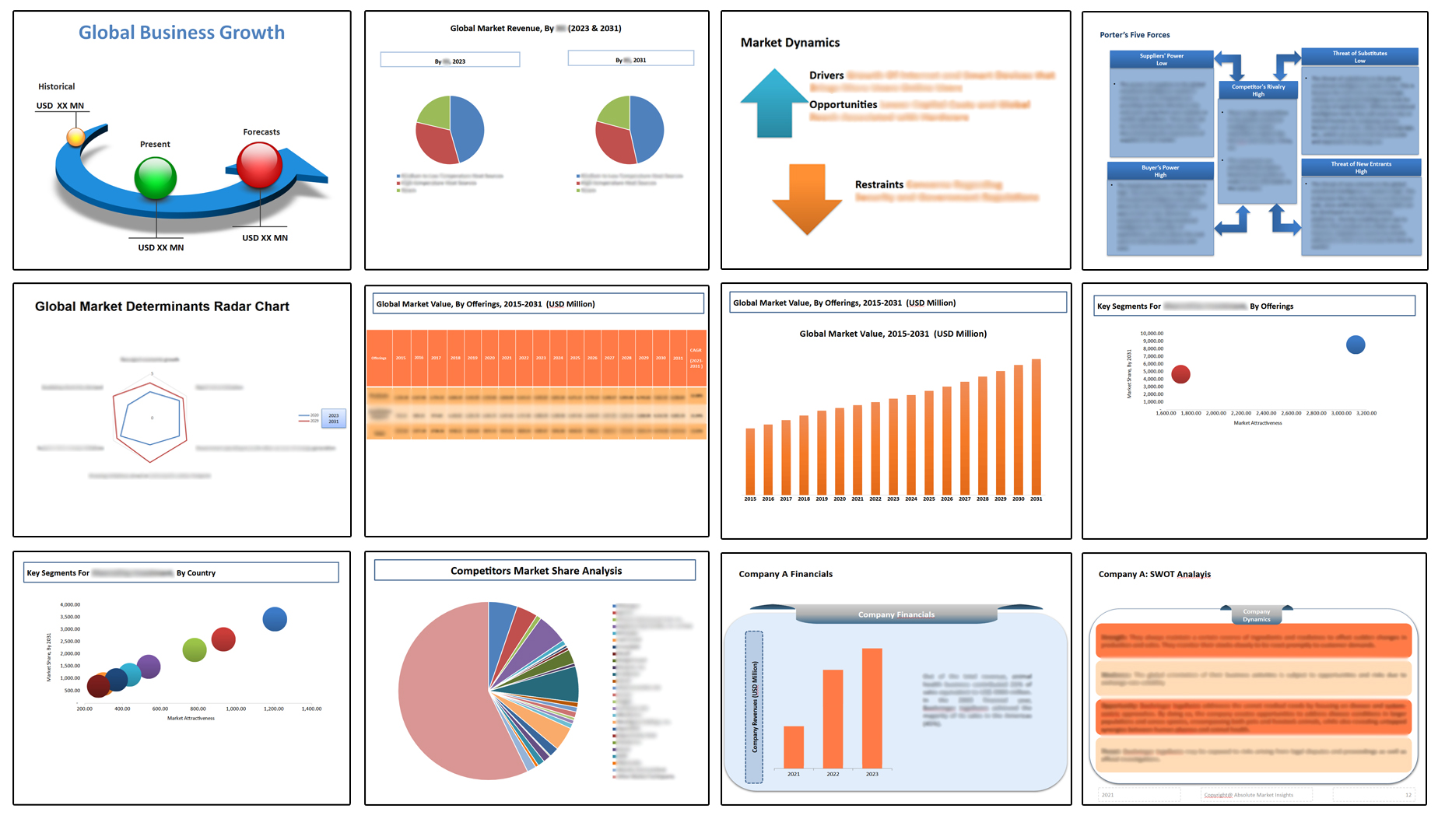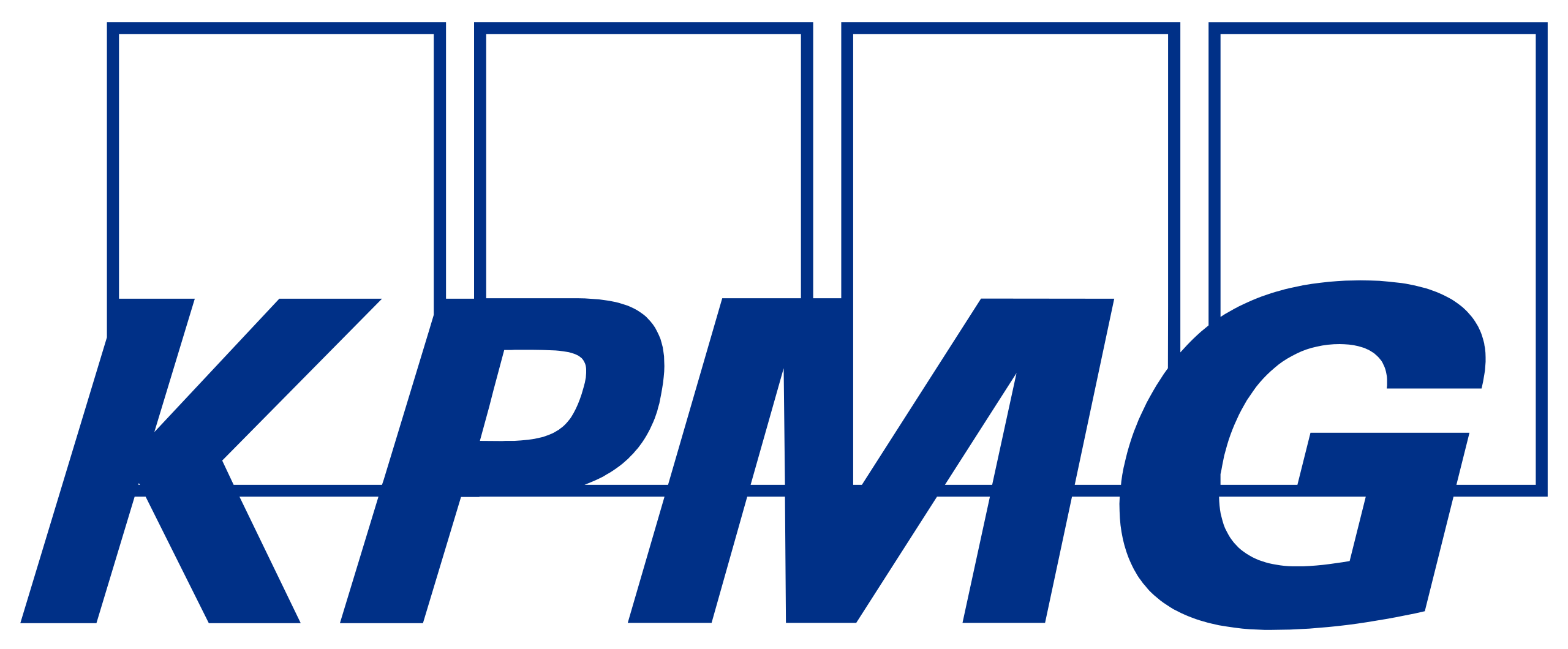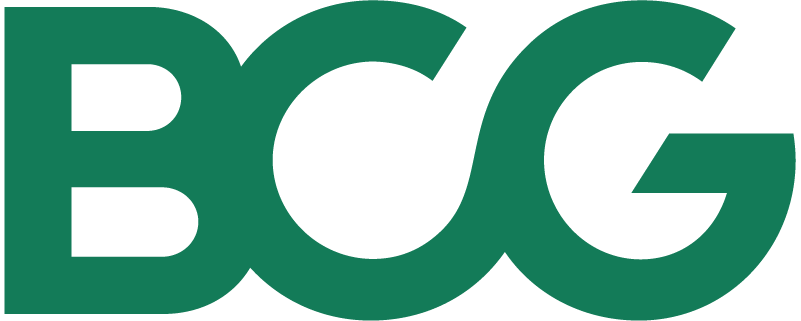Global Animal Model Market By Animal Type, By Technology, By Application, By End User & By Region: Global Insights, Comparative Analysis, Trends and Forecasts, 2023 – 2031
- Industry: Healthcare
- Report ID: TNR-110-911
- Number of Pages: 420
- Table/Charts : Yes
- November, 2023
- Base Year : 2024
- No. of Companies : 11+
- No. of Countries : 29
- Views : 10276
- Covid Impact Covered: Yes
- War Impact Covered: Yes
- Formats : PDF, Excel, PPT
Global Animal Model Market was valued at US$ 1.91 Billion in 2022, growing at an estimated CAGR of 6.3% from 2023-2031.
An animal model is a living organism, typically an animal species like rodents, primates, or pigs, used in scientific research to study and understand biological processes, diseases, and human health. These models help researchers investigate complex biological mechanisms, test new therapies, and predict the potential effects of treatments before moving to human trials. By simulating physiological and genetic aspects of human conditions, animal models provide insights into disease progression, treatment responses, and safety assessments. Despite their utility, ethical concerns arise due to the use of animals in research. As such, scientists strive to develop alternatives like cell cultures and computer simulations. Animal models remain essential tools for advancing medical knowledge and improving human well-being while raising ethical questions that underline the need for responsible research practices. Among the animal types, mice and rats are typically the dominating and most commonly used species in scientific research due to their genetic similarity to humans and ease of handling. They constitute a substantial majority of animals used in research, with mice being particularly favored due to their short generation time and well-established genetic manipulation techniques.
Global Animal Model Market Revenue & Forecast, (US$ Million), 2015 – 2031

COVID-19 Impact Analysis on Global Animal Model Market
Pre-COVID-19, the animal model market was witnessing steady growth driven by pharmaceutical, biotechnology, and academic research. The demand for animal models, primarily mice and rats, was fueled by the need to understand diseases, develop therapies, and test drug efficacy. However, the pandemic introduced significant disruptions. Research activities were temporarily halted or redirected towards COVID-19 studies, diverting resources and attention. Despite this, the crisis also highlighted the importance of animal models in vaccine and drug development. Post-COVID-19, the market is adapting with renewed emphasis on infectious disease research. The accelerated vaccine development showcased the agility of animal models in testing treatments. While challenges remain, the pandemic reinforced the critical role of animal models in biomedical research, potentially leading to increased investments and advancements in the field.
Report Outline
 Advancements in genetic engineering have been a key driver of the animal model market. Techniques like CRISPR-Cas9 have revolutionized the creation of genetically modified animals for disease modeling, drug testing, and understanding gene function. For instance, a survey by the International Society for Transgenic Technologies reported that the use of CRISPR-Cas9 in creating animal models has rapidly increased since its inception, contributing to more accurate disease simulations. This trend enables researchers to develop models that closely mimic human conditions, enhancing the reliability of research outcomes and drug development. Ethical concerns surrounding animal welfare and increasing regulatory pressure have posed significant challenges to the animal model market. Public opinion on animal testing is evolving, and regulations are becoming more stringent. A study by Pew Research Center indicated that a considerable percentage of people expressed concerns about animal research. Additionally, governments and organizations are pushing for alternatives to animal models. The implementation of the 3Rs principle (Replacement, Reduction, Refinement) is gaining traction, urging researchers to seek alternatives, reduce animal use, and refine experimental techniques. These factors create a delicate balance between scientific progress and ethical considerations in the animal model industry.
Advancements in genetic engineering have been a key driver of the animal model market. Techniques like CRISPR-Cas9 have revolutionized the creation of genetically modified animals for disease modeling, drug testing, and understanding gene function. For instance, a survey by the International Society for Transgenic Technologies reported that the use of CRISPR-Cas9 in creating animal models has rapidly increased since its inception, contributing to more accurate disease simulations. This trend enables researchers to develop models that closely mimic human conditions, enhancing the reliability of research outcomes and drug development. Ethical concerns surrounding animal welfare and increasing regulatory pressure have posed significant challenges to the animal model market. Public opinion on animal testing is evolving, and regulations are becoming more stringent. A study by Pew Research Center indicated that a considerable percentage of people expressed concerns about animal research. Additionally, governments and organizations are pushing for alternatives to animal models. The implementation of the 3Rs principle (Replacement, Reduction, Refinement) is gaining traction, urging researchers to seek alternatives, reduce animal use, and refine experimental techniques. These factors create a delicate balance between scientific progress and ethical considerations in the animal model industry.
 In the global animal model market, pharma and biotech companies have established dominance and are experiencing faster growth compared to academic research institutes. Pharma and biotech companies heavily rely on animal models to conduct preclinical trials and test the safety and efficacy of potential drug candidates. According to a study published in the journal “Nature Reviews Drug Discovery,” the use of animal models in drug development has significantly contributed to successful clinical trials. This demand has led to a substantial investment in animal models by these companies.
In the global animal model market, pharma and biotech companies have established dominance and are experiencing faster growth compared to academic research institutes. Pharma and biotech companies heavily rely on animal models to conduct preclinical trials and test the safety and efficacy of potential drug candidates. According to a study published in the journal “Nature Reviews Drug Discovery,” the use of animal models in drug development has significantly contributed to successful clinical trials. This demand has led to a substantial investment in animal models by these companies.
North America conquered major market share in the global animal model market in 2022 due to the concentration of major pharmaceutical and biotechnology firms. The US National Institutes of Health (NIH) reported that the demand for animal models remains high for drug development and disease research in this region.

Competitive Landscape
The report provides both, qualitative and quantitative research of global animal model market, as well as provides comprehensive insights and development methods adopted by the key contenders. The report also offers extensive research on the key players in this market and details on the competitiveness of these players. Key business strategies such as mergers and acquisitions (M&A), affiliations, collaborations, and contracts adopted by these major market participants are also recognized and analyzed in the report. For each company, the report studies their global presence, competitors, service offerings and specification amongst others.
Some of the players operating in the global animal model market are
- Charles River Laboratories
- Crown Bioscience
- genOway
- Hera Biolabs
- Inotiv
- Janvier Labs
- Ozgene Pty Ltd.
- Taconic Biosciences, Inc.
- The Jackson Laboratory
- Trans Genic Inc.
- Other Industry Participants
Global Animal Model Market Summary
| Report Specifications | Details |
| Market Revenue in 2022 | US$ 1.91 Bn |
| Market Size Forecast by 2031 | US$ 3.18 Bn |
| Growth Rate (CAGR) | 6.3% |
| Historic Data | 2015 – 2021 |
| Base Year for Estimation | 2022 |
| Forecast Period | 2023 – 2031 |
| Report Inclusions | Market Size & Estimates, Market Dynamics, Competitive Scenario, Trends, Growth Factors, Market Determinants, Key Investment Segmentation, Product/Service/Solutions Benchmarking |
| Segments Covered | By Animal Type, By Technology, By Application, By End User, By Region |
| Regions Covered | North America, Europe, Asia Pacific, Middle East & Africa, Latin America |
| Countries Covered | U.S., Canada, Mexico, Rest of North America, France, The UK, Spain, Germany, Italy, Nordic Countries (Denmark, Finland, Iceland, Sweden, Norway), Benelux Union (Belgium, The Netherlands, Luxembourg), Rest of Europe, China, Japan, India, New Zealand, Australia, South Korea, Southeast Asia (Indonesia, Thailand, Malaysia, Singapore, Rest of Southeast Asia), Rest of Asia Pacific, Saudi Arabia, UAE, Egypt, Kuwait, South Africa, Rest of Middle East & Africa, Brazil, Argentina, Rest of Latin America |
| Key Players | Charles River Laboratories, Crown Bioscience, genOway, Hera Biolabs, Inotiv, Janvier Labs, Ozgene Pty Ltd., Taconic Biosciences, Inc., The Jackson Laboratory, Trans Genic Inc., Other Industry Participants |
| Customization Scope | Customization allows for the inclusion/modification of content pertaining to geographical regions, countries, and specific market segments. |
| Pricing & Procurement Options | Explore purchase options tailored to your specific research requirements |
| Contact Details | Consult With Our Expert
Japan (Toll-Free): +81 663-386-8111 South Korea (Toll-Free): +82-808- 703-126 Saudi Arabia (Toll-Free): +966 800-850-1643 United Kingdom: +44 753-710-5080 United States: +1 302-232-5106 E-mail: askanexpert@thenicheresearch.com
|
Global Animal Model Market
By Animal Type
- Mice
- Rats
- Fish
- Birds
- Cattle
- Pigs
- Amphibians
- Guinea Pigs
- Dogs
- Cats
- Rabbits
- Monkeys
- Sheep
- Hamsters
- Other animal types
By Technology
- CRISPR
- Microinjection
- Embryonic Stem Cell Injection
- Nuclear Transfer
- Other technologies
By Application
- Drug Discovery and Development
- Basic Research
- Others
By End User
- Pharma and Biotech Companies
- Academic Research Institutes
- CROs and CDMOs
By Region
- North America (U.S., Canada, Mexico, Rest of North America)
- Europe (France, The UK, Spain, Germany, Italy, Nordic Countries (Denmark, Finland, Iceland, Sweden, Norway), Benelux Union (Belgium, The Netherlands, Luxembourg), Rest of Europe)
- Asia Pacific (China, Japan, India, New Zealand, Australia, South Korea, Southeast Asia (Indonesia, Thailand, Malaysia, Singapore, Rest of Southeast Asia), Rest of Asia Pacific)
- Middle East & Africa (Saudi Arabia, UAE, Egypt, Kuwait, South Africa, Rest of Middle East & Africa)
- Latin America (Brazil, Argentina, Rest of Latin America)
Table of Contents
**Exclusive for Multi-User and Enterprise User.
Global Animal Model Market
By Animal Type
By Technology
By Application
By End User
By Region
**Note: The report covers cross-segmentation analysis by region further into countries
The Niche Research approach encompasses both primary and secondary research methods to provide comprehensive insights. While primary research is the cornerstone of our studies, we also incorporate secondary research sources such as company annual reports, premium industry databases, press releases, industry journals, and white papers.
Within our primary research, we actively engage with various industry stakeholders, conducting paid interviews and surveys. Our meticulous analysis extends to every market participant in major countries, allowing us to thoroughly examine their portfolios, calculate market shares, and segment revenues.
Our data collection primarily focuses on individual countries within our research scope, enabling us to estimate regional market sizes. Typically, we employ a bottom-up approach, meticulously tracking trends in different countries. We analyze growth drivers, constraints, technological innovations, and opportunities for each country, ultimately arriving at regional figures.Our process begins by examining the growth prospects of each country. Building upon these insights, we project growth and trends for the entire region. Finally, we utilize our proprietary model to refine estimations and forecasts.
Our data validation standards are integral to ensuring the reliability and accuracy of our research findings. Here’s a breakdown of our data validation processes and the stakeholders we engage with during our primary research:
- Supply Side Analysis: We initiate a supply side analysis by directly contacting market participants, through telephonic interviews and questionnaires containing both open-ended and close-ended questions. We gather information on their portfolios, segment revenues, developments, and growth strategies.
- Demand Side Analysis: To gain insights into adoption trends and consumer preferences, we reach out to target customers and users (non-vendors). This information forms a vital part of the qualitative analysis section of our reports, covering market dynamics, adoption trends, consumer behavior, spending patterns, and other related aspects.
- Consultant Insights: We tap into the expertise of our partner consultants from around the world to obtain their unique viewpoints and perspectives. Their insights contribute to a well-rounded understanding of the markets under investigation.
- In-House Validation: To ensure data accuracy and reliability, we conduct cross-validation of data points and information through our in-house team of consultants and utilize advanced data modeling tools for thorough verification.
The forecasts we provide are based on a comprehensive assessment of various factors, including:
- Market Trends and Past Performance (Last Five Years): We accurately analyze market trends and performance data from preceding five years to identify historical patterns and understand the market’s evolution.
- Historical Performance and Growth of Market Participants: We assess the historical performance and growth trajectories of key market participants. This analysis provides insights into the competitive landscape and individual company strategies.
- Market Determinants Impact Analysis (Next Eight Years): We conduct a rigorous analysis of the factors that are projected to influence the market over the next eight years. This includes assessing both internal and external determinants that can shape market dynamics.
- Drivers and Challenges for the Forecast Period:Identify the factors expected to drive market growth during the forecast period, as well as the challenges that the industry may face. This analysis aids in deriving an accurate growth rate projection.
- New Acquisitions, Collaborations, or Partnerships: We keep a close watch on any new acquisitions, collaborations, or partnerships within the industry. These developments can have a significant impact on market dynamics and competitiveness.
- Macro and Micro Factors Analysis:A thorough examination of both macro-level factors (e.g., economic trends, regulatory changes) and micro-level factors (e.g., technological advancements, consumer preferences) that may influence the market during the forecast period.
- End-User Sentiment Analysis: To understand the market from the end-user perspective, we conduct sentiment analysis. This involves assessing the sentiment, preferences, and feedback of the end-users, which can provide valuable insights into market trends.
- Perspective of Primary Participants: Insights gathered directly from primary research participants play a crucial role in shaping our forecasts. Their perspectives and experiences provide valuable qualitative data.
- Year-on-Year Growth Trend: We utilize a year-on-year growth trend based on historical market growth and expected future trends. This helps in formulating our growth projections, aligning them with the market’s historical performance.
Research process adopted by TNR involves multiple stages, including data collection, validation, quality checks, and presentation. It’s crucial that the data and information we provide add value to your existing market understanding and expertise. We have also established partnerships with business consulting, research, and survey organizations across regions and globally to collaborate on regional analysis and data validation, ensuring the highest level of accuracy and reliability in our reports.









